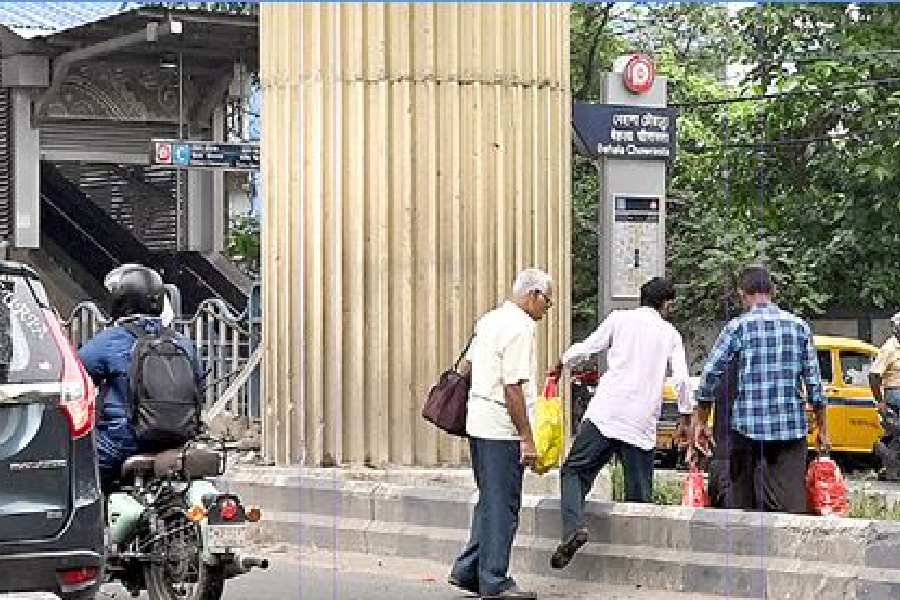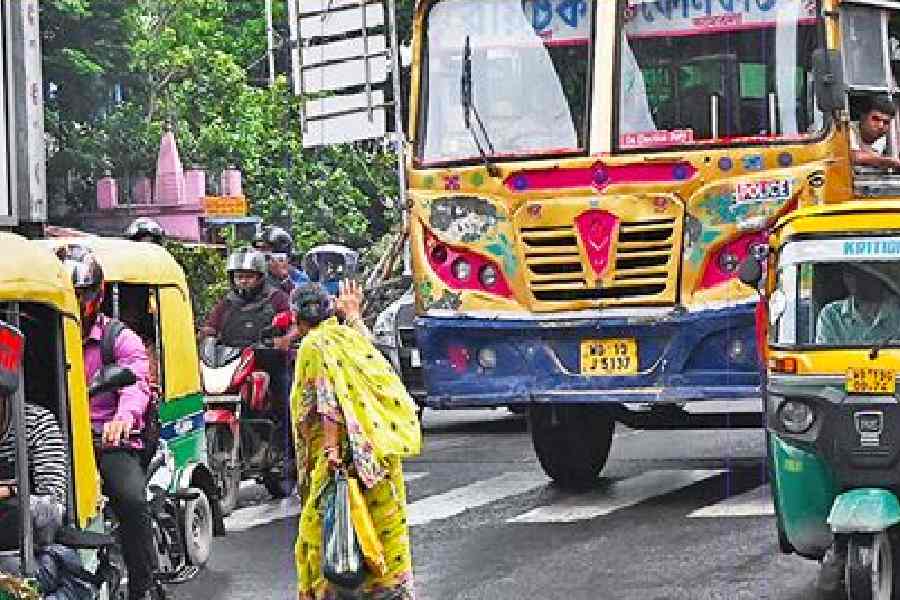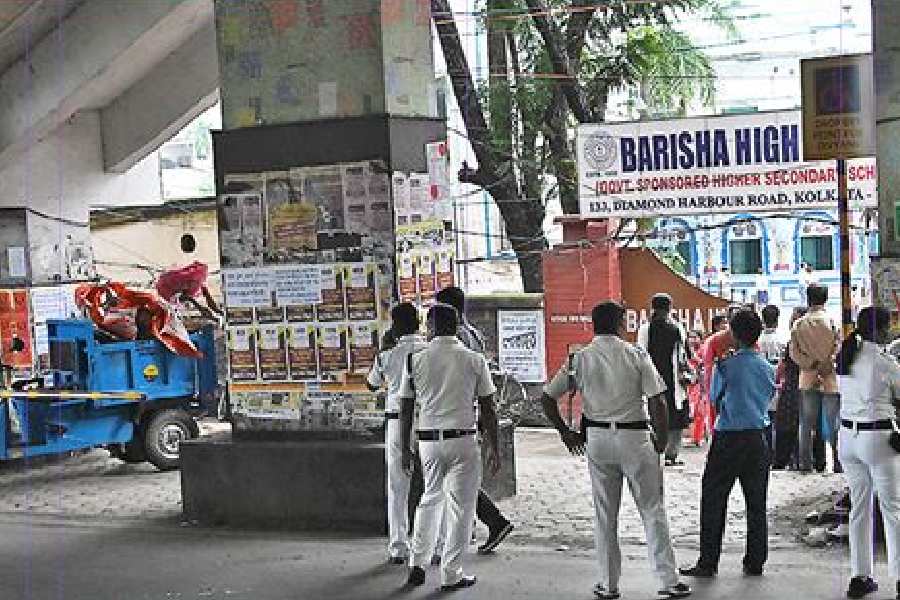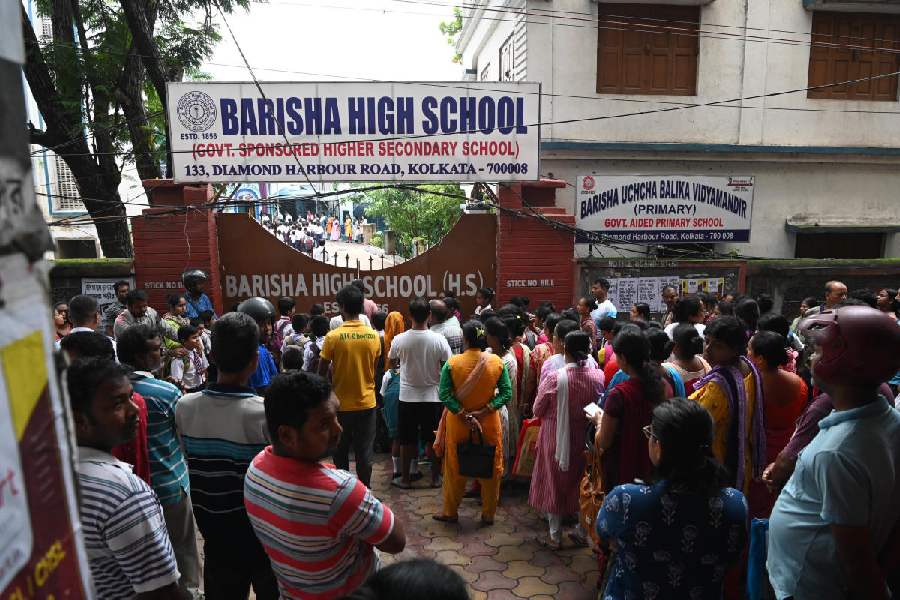The Chowrasta intersection on Diamond Harbour Road seemed a different place on Monday, the first working day after the Friday accident that killed eight-year-old Souraneel and injured his father, Saroj Kumar Sarkar. Traffic was smooth on the road on both sides of what is usually one of the most chaotic crossroads in Calcutta. But one familiar problem remained — jaywalking. Following the accident on Friday, a mob took over a large stretch of Diamond Harbour Road. Traffic on the thoroughfare was choked for close to four hours. By Saturday, the police had installed multiple drop gates or boom barriers at strategic locations on Diamond Harbour Road. Debraj Mitra and Monalisa Chaudhuri of The Telegraph spent around two hours at the intersection, in two phases, on Monday. Here’s what they saw

Three men hop across the median divider on Diamond Harbour Road from the Thakurpukur-bound flank to get on the Taratala-bound flank on Monday morning.
WHAT WORKED....
One of the most visible changes was in the movement of vehicles through the Behala Chowrasta intersection.
On a typical day, even during non-rush hours, driving through the stretch would be a nightmare for law-abiding motorists.
Buses and autos would intentionally go slow to look for passengers even when the signal was green. Often, a bus or an auto would stop to wait for a passenger waving hand from the opposite flank.
As a result, the vehicles behind would also get slower.
On Monday, however, home guards and civic volunteers continuously prodded the vehicles to keep moving. A bus or an auto that tried to go slow got an earful from a sergeant.
A drop gate that went up and came down in sync with the signals was instrumental in streamlining the movement of pedestrians. The cops ensured that the majority of pedestrians waited behind the barrier and crossed the road through the zebra crossing at the right time.
Earlier, pedestrians would cross the road from wherever, and whenever, they wanted. A raised hand seemed to be their licence to walk across the thoroughfare whenever they wished.
On Monday, guard rails and bollards created dedicated walkways for pedestrians that were largely adhered to.
The combined impact of smooth vehicular movement and improved pedestrian discipline was significant.
Till last week, it would often take a car around 10 minutes to cross a 500km stretch of Diamond Harbour Road at Chowrasta during rush hours.
A snarl would inevitably start much before the Chowrasta signal on both flanks — Taratala-bound and Thakurpukur-bound — of the thoroughfare.
On Monday, the time was reduced to less than five minutes.
Raja Rammohan Roy Road, a key link between Chowrasta and Tollygunge, meets Diamond Harbour Road on its Thakurpukur-bound flank.
Biren Roy Road West, which leads to Sarsuna, Shakuntala Park and Maheshtala, on the southwestern fringes, meets Diamond Harbour Road on its Taratala-bound flank.

A policemen stops a cyclist moving against the flow of traffic on Diamon Harbour Road near Behala Chowrasta on Monday.
Vehicles on Diamond Harbour Road, headed to both the connecting roads, have to turn left or right or make a U-turn, depending on the flank they are on. But on usual days, they do not wait in their designated lanes before taking the turn and eat up into the remaining portion of the road as well.
On Monday, the vehicles about to take a turn did not deviate from their designated waiting zones.
The unruly movement of autos is also one of the major problems on the Chowrasta stretch.
On Monday, there were fixed corridors for autos to return to their stand after completing a trip. Earlier, many autos would take an U-turn arbitrarily to get back to the stand.
“Additional deployment always helps in implementing traffic rules. We held meetings with guardians of schoolkids. We also held a meeting with auto drivers,” said an officer of the traffic department of Calcutta police.
....WHAT DID NOT WORK
Despite heavy police deployment and all the measures in place, jaywalking was common at Behala Chowrasta on Monday.
Every now and then, a pedestrian ignored the zebra crossing when they wanted to walk across the perennially busy thoroughfare.
In two hours spent at the Chowrasta and Sakherbazar (the next major crossroads after Chowrasta towards Thakurpukur) intersections on Diamond Harbour Road, Metro spotted at least 15 incidents of jaywalking.
Individually, these did not have an impact on the overall traffic management. But a difference of a few seconds could have led to an accident in many cases.
Around 6.30am, a man on the Thakurpukur-bound flank of Diamond Harbour Road walked with a mobile phone glued to his left ear, oblivious of the cars whizzing past him.
As he walked, he was almost brushing the guard rails set up to create a walkway. Only that he was just outside that zone.
Around 11.10am, two women came from the Taratala-bound flank to the Thakurpukur-bound flank through the middle of the road. Even after getting on the Thakurpukur-bound flank, they walked through the middle of the road to reach the pavement.
Seconds later, three men jumped across the median divider to get on the Taratala-bound flank.

An elderly woman crosses Diamond Harbour Road at the Sakherbazar intersection when the signal is green for vehicles on Monday.
A homeguard posted outside Barisha Uchcha Balika Vidyamandir — the school of eight-year-old Souraneel Sarkar, who was mowed down by a lorry on Friday morning at Chowrasta — kept prodding pedestrians to walk through the corridor marked by guardrails and bollards.
While most pedestrians obliged, some continued to walk through the unmarked section, meant for vehicles.
In this city, rampant jaywalking is also the consequence of footpaths being encroached upon and many streets not having any.
While a small stretch of the pavement in front of the school has been cleared of hawkers, the remaining pavements in Chowrasta remain clogged with vendors.
But even before reaching the pavement, Calcutta pedestrians’ infamous impatience at traffic signals was evident again on Monday.
Around 11.25pm, a woman started walking across the Thakurpukur-bound flank, towards the other flank, when the signal for vehicles was green. She was almost trapped between a number of cars, prompting a traffic constable to swing into action and help her cross the road.
Around 600m away, at the Sakherbazar crossing, the police deployment was lighter than that in Chowrasta.
Around 11.45am, the signal for pedestrian was green. Many pedestrians were walking across the road, but almost none through the zebra crossing.
Seconds later, when the signal for vehicles turned green, an elderly woman chose to cross the road. A raised right hand was her passport to safety. A bus on the Raichak-Esplanade route stopped to make way for her.
Jaywalking has often been identified by the police as the primary trigger for many accidents in Calcutta. “Around 50 per cent of road accident victims in Calcutta are pedestrians.,” said an officer at Lalbazar.

